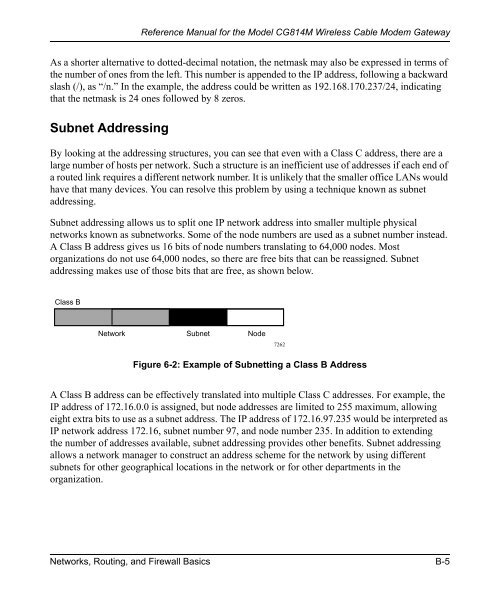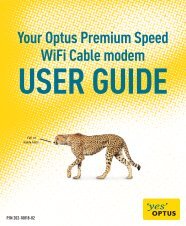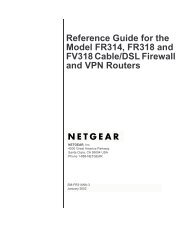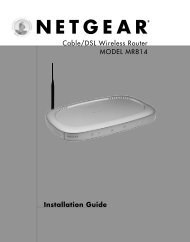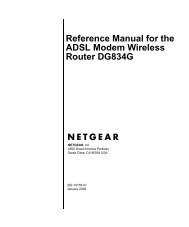Reference Manual for the Model CG814M Wireless Cable ... - netgear
Reference Manual for the Model CG814M Wireless Cable ... - netgear
Reference Manual for the Model CG814M Wireless Cable ... - netgear
Create successful ePaper yourself
Turn your PDF publications into a flip-book with our unique Google optimized e-Paper software.
<strong>Reference</strong> <strong>Manual</strong> <strong>for</strong> <strong>the</strong> <strong>Model</strong> <strong>CG814M</strong> <strong>Wireless</strong> <strong>Cable</strong> Modem Gateway<br />
As a shorter alternative to dotted-decimal notation, <strong>the</strong> netmask may also be expressed in terms of<br />
<strong>the</strong> number of ones from <strong>the</strong> left. This number is appended to <strong>the</strong> IP address, following a backward<br />
slash (/), as “/n.” In <strong>the</strong> example, <strong>the</strong> address could be written as 192.168.170.237/24, indicating<br />
that <strong>the</strong> netmask is 24 ones followed by 8 zeros.<br />
Subnet Addressing<br />
By looking at <strong>the</strong> addressing structures, you can see that even with a Class C address, <strong>the</strong>re are a<br />
large number of hosts per network. Such a structure is an inefficient use of addresses if each end of<br />
a routed link requires a different network number. It is unlikely that <strong>the</strong> smaller office LANs would<br />
have that many devices. You can resolve this problem by using a technique known as subnet<br />
addressing.<br />
Subnet addressing allows us to split one IP network address into smaller multiple physical<br />
networks known as subnetworks. Some of <strong>the</strong> node numbers are used as a subnet number instead.<br />
A Class B address gives us 16 bits of node numbers translating to 64,000 nodes. Most<br />
organizations do not use 64,000 nodes, so <strong>the</strong>re are free bits that can be reassigned. Subnet<br />
addressing makes use of those bits that are free, as shown below.<br />
Class B<br />
Network Subnet Node<br />
Figure 6-2: Example of Subnetting a Class B Address<br />
A Class B address can be effectively translated into multiple Class C addresses. For example, <strong>the</strong><br />
IP address of 172.16.0.0 is assigned, but node addresses are limited to 255 maximum, allowing<br />
eight extra bits to use as a subnet address. The IP address of 172.16.97.235 would be interpreted as<br />
IP network address 172.16, subnet number 97, and node number 235. In addition to extending<br />
<strong>the</strong> number of addresses available, subnet addressing provides o<strong>the</strong>r benefits. Subnet addressing<br />
allows a network manager to construct an address scheme <strong>for</strong> <strong>the</strong> network by using different<br />
subnets <strong>for</strong> o<strong>the</strong>r geographical locations in <strong>the</strong> network or <strong>for</strong> o<strong>the</strong>r departments in <strong>the</strong><br />
organization.<br />
Networks, Routing, and Firewall Basics B-5<br />
7262


